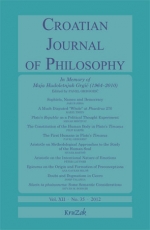The Constitution of the Human Body in Plato’s Timaeus
The Constitution of the Human Body in Plato’s Timaeus
Author(s): Filip KarfíkSubject(s): Philosophy
Published by: KruZak
Keywords: regeneration; respiration; digestion; circulation; soul; death; world; immortal; mortal
Summary/Abstract: The author emphasizes the fact that the largest part of Plato’s Timaeus deals with human nature and offers a detailed account of the constitution of the human body. He then lists the parallels and the differences between the constitution of the world body and the human body. The central part of the paper deals with Plato’s explanation of the persistence of the human body within a bodily environment which causes its dissolution. The author pays a special attention to Plato’s theory of the apparatus which keeps running the processes of respiration, digestion and blood circulation. In the concluding section, the author raises the question of the relationship between human body and human soul. He shows that, in Plato’s Timaeus, the human body functions to a large extent independently from human soul. One possible reason for this theory is Plato’s conception of the immortal soul. While the human body exists in order to harbour the immortal soul, the latter does not produce and preserve it nor does it cause its dissolution. It only exercises cognitive and ruling functions in it as long as the body is able to hold together and to detain the soul.
Journal: Croatian Journal of Philosophy
- Issue Year: XII/2012
- Issue No: 35
- Page Range: 167-181
- Page Count: 15
- Language: English
- Content File-PDF

